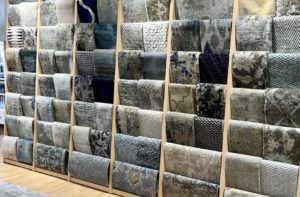Personal Attention: Artist Ann Mallory
August 16, 2016
A prolific Woodbury artist creates soulful, purposeful, and mindful sculptures that seem otherworldly at first, but deeply familiar at last.
Text by Allegra Muzzillo
Ann Mallory can’t imagine a life without clay. There’s a photo of her, age eight, sitting under her family’s lemon tree making adobe-mud pies and enjoying every minute of it. “I really loved sticking my hands into that soft, squishy medium,” Mallory recalls. By high school, the Southern California native had developed a deep appreciation for clay’s finished form, too. At summer art class in a space that’s now the Norton Simon Museum in Pasadena, she remembers running her hands over an exterior wall. “I noticed the smoothness of the ceramic openwork tiling,” she says. “It evoked a real sensuousness.”
During that time, Mallory’s “personal sunrise” (a term she lovingly uses to describe an artistic awakening in her young life) came once she was given access to a neighbor’s old kick wheel. She had been frustrated by the rigidity of hard clay. But as she practiced on the wheel, the clay became wetter, softer, more pliant. Since then, she has used only the softest clays— and has cultivated a huge, ever-evolving body of ceramic sculpture that spans nearly forty years.
Mallory has worked under the tutelage of several of the ceramic art world’s heaviest hitters, including Susan Peterson at the University of Southern California in 1969, Marguerite and Frans Wildenhain after she graduated from Stanford in 1971, and Bruce and Phyllis Murray during a period when she lived in Vermont in the mid-1970s. But it was a six-week intensive exchange program in Tokyo in 1980, where Mallory absorbed technique from masters of the Eastern style, that changed everything.
In fact, she had always been enamored with Asian artwork—her father, a code-breaker in World War II, collected woodblock prints and ivory carvings that had pride of place in Mallory’s childhood home. “I liked the simplicity of Japanese forms and their glazes, too,” she says. “Asian ceramics just make my heart sing a bit more than European forms.”
When observed as a whole, Mallory’s body of work exists on a timeless, otherworldly plane that’s both sensual in form and tactility and chaste in meaning and function. The unique forms seem vaguely familiar, too, and range from small, globular, hollowed-out, wire-wrapped clay entities she calls Bundles to totem-like four- and five-foot vertical Standing Stones composed of separate cube-like shapes mounted on welded steel bases. Mallory blends all her own glazes, composed of a measured mix of silica (which determines the sheen of each piece) and naturally occurring oxides (for pigment), and often uses sifted fireplace ash for added texture and color, begetting yet another “very Asian sensibility,” she says.
Her Contemplation Vessels, for example, are sculptural, boulder-like objects whose tops hold shallow indentations and openings for water to trickle into and sit. They look ancient, as though they’ve been carved by eons’ worth of running streams. Here, the artist uses both Eastern throwing traditions (which favor hand work and wooden tools) and European techniques (employing metal ribbing and tools for a tighter, more compressed result) to create shape inside her forms.
Mallory makes use of other materials, as well. When clients worried the vessels weren’t durable enough to live outdoors, she began casting the containers in bronze via lost-wax technique. She also uses unexpected, everyday materials like crumpled newspapers inside paper bags and upholstery foam remnants onto which she hand-applies rolled-out slabs of clay to help her asymmetrical Standing Stones stand and her breathy, comforting, cocoon-like Casings rise and take shape.
In her studio, a space she calls her “personal temple,” Mallory’s process flourishes. The vast, high-ceilinged room closely resembles a state-of-the-art gallery or museum, down to its white-plaster walls, strategically placed banks of windows, and LED track lights. This is where Mallory begins with the seed of an idea, and then sketches two-dimensional pencil-and-paper drawings and small, three-dimensional studies in clay. Her current work includes Contemplation Vessels that take on more angular, rugged, less refined forms, as well as a new series of freestanding vertical sculptures of tile and iron.
These works will undoubtedly jibe with her past and future ones, as each piece seems to share a murmuring, age-old dialogue. “I always knew I could grow old doing this and still wouldn’t do it all,” Mallory says. “I’m still learning every time I open a kiln—and I like that very much.” •
Editor’s note: Ann Mallory is represented in Connecticut by Argazzi Art, Lakeville, (860) 435-8222, argazziart.com. To see more of her work, visit annmallory.com.
Share
![NEH-Logo_Black[1] NEH-Logo_Black[1]](https://www.nehomemag.com/wp-content/uploads/2022/08/NEH-Logo_Black1-300x162.jpg)

















You must be logged in to post a comment.